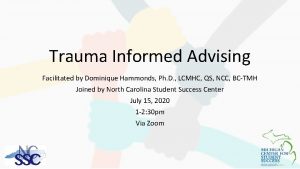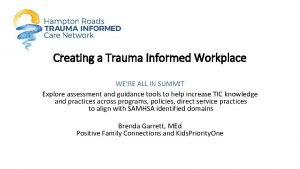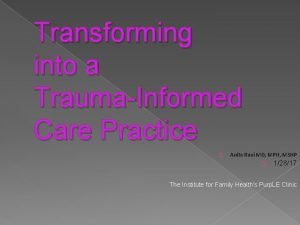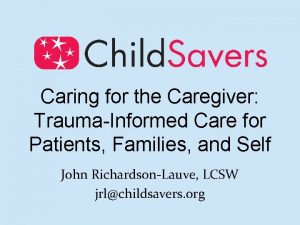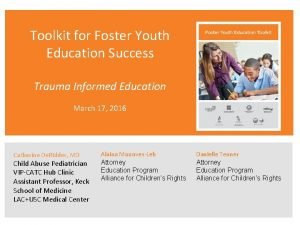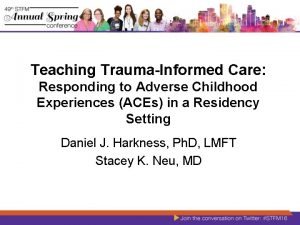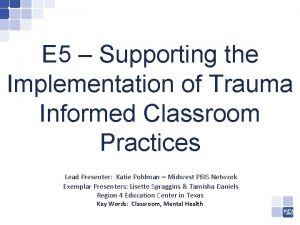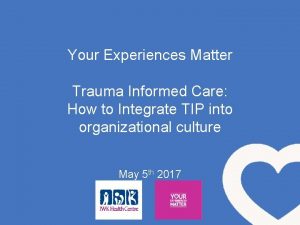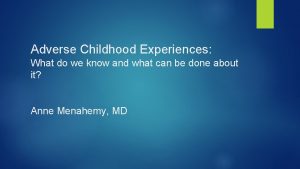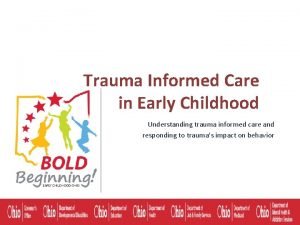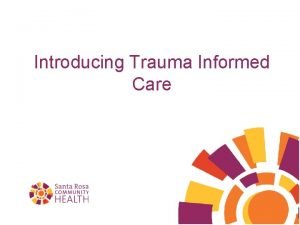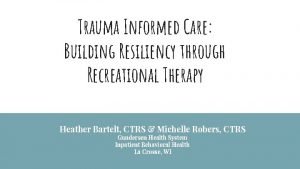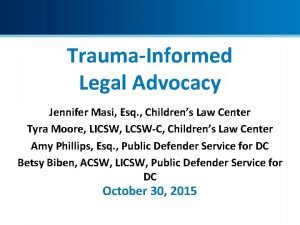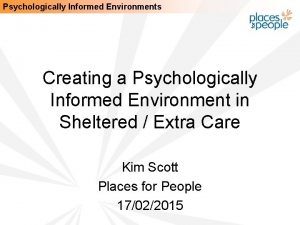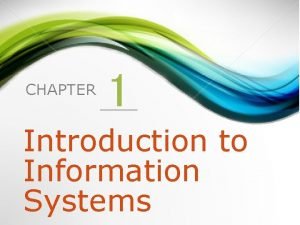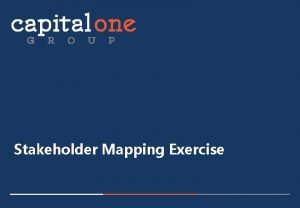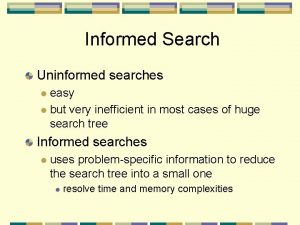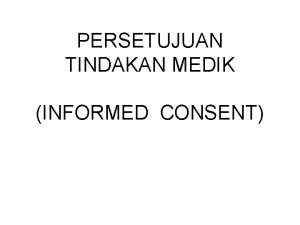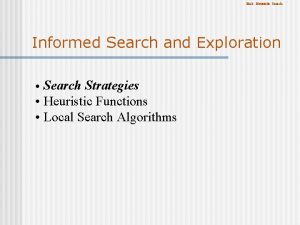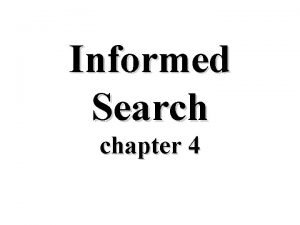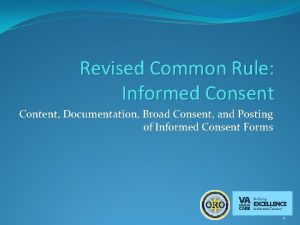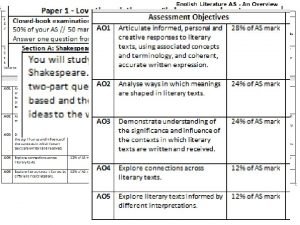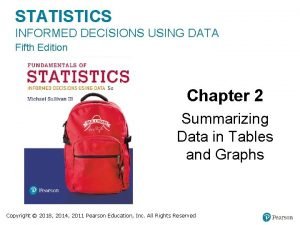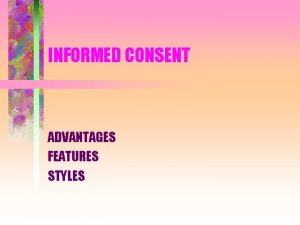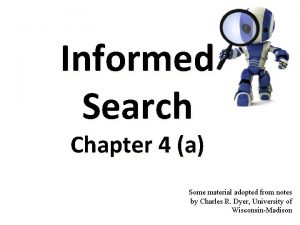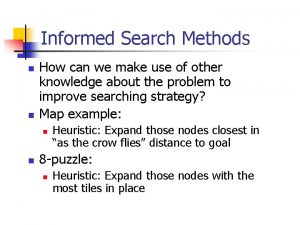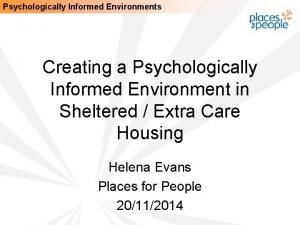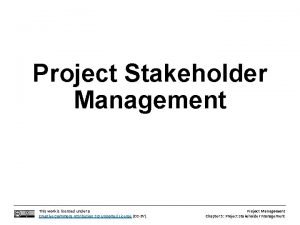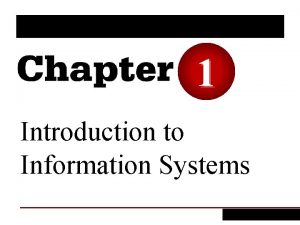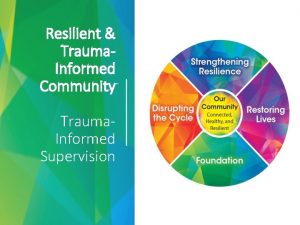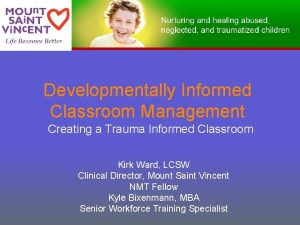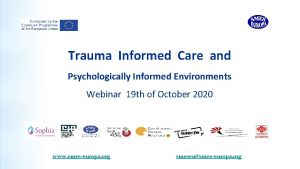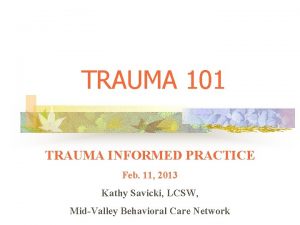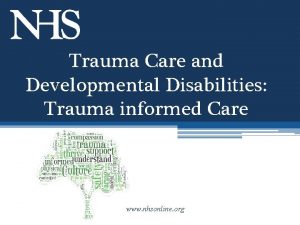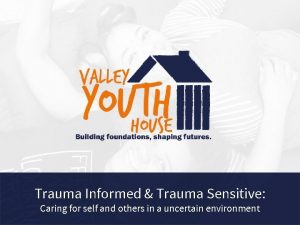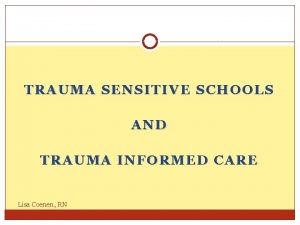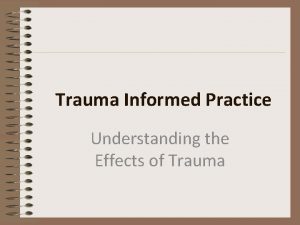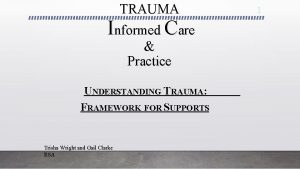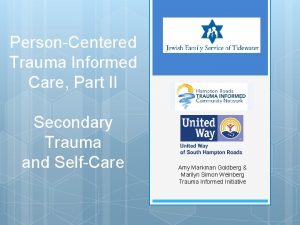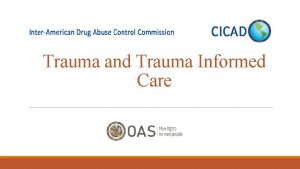E 5 Supporting the Implementation of Trauma Informed

























































































- Slides: 89

E 5 – Supporting the Implementation of Trauma Informed Classroom Practices Lead Presenter: Katie Pohlman – Midwest PBIS Network Exemplar Presenters: Lisette Spraggins & Tamisha Daniels Region 4 Education Center in Texas Key Words: Classroom, Mental Health MIDWEST PNETWORK BIS

Big Take-Aways ü SW-PBIS provides framework for installing trauma informed practices. This means Data and Systems, not just Practices!! ü SW-PBIS practices are trauma informed ü Six defined classroom practices are aligned to SW -PBIS ü Implementing these practices with fidelity creates a safe, predictable, consistent, safe, and equitable OR trauma informed environment ü Link trauma informed strategies to evidence based practices MIDWEST PNETWORK BIS

Miami, FL Hyatt Regency Miami March 11 -14, 2020 For more information, visit: conference. apbs. org MIDWEST PNETWORK BIS


WHY? MIDWEST PNETWORK BIS

To a youth experienced trauma, Some see who bearshas in forests… anything can look like a bear We may not know what their BEAR looks like or. A when they last The touch minute of a change saw a BEAR… we shoulder however, in can remember ifroutine they have seen a BEAR before, their A raised Voice wiring may have been set up Noise to see BEARS everywhere. MIDWEST PNETWORK BIS

ALWAYS ON GUARD! MIDWEST PNETWORK BIS

What Flight, Fight, or Freeze Looks Like in the Classroom Flight Freeze • Withdrawing • Acting out • Exhibiting numbness • Fleeing the classroom • Behaving aggressively • Refusing to answer • Skipping class • Acting silly • Refusing to get needs met • Daydreaming • Exhibiting defiance • Giving a blank look • Seeming to sleep • Being hyperactive • Feeling unable to move/act • Avoiding others • Arguing • Hiding or wandering • Screaming/yelling • Becoming disengaged Fostering Resilient Learners Strategies for Creating a Trauma-Sensitive Classroom Kristin Souers with Pete Hall MIDWEST PNETWORK BIS

WHAT IS TRAUMA INFORMED? MIDWEST PNETWORK BIS

Framework for Student Supports Purpose of PBIS …to make schools more effective and equitable learning environments for ALL students. Predictable Consistent Positive Equitable Trauma Responsive Safe Systems MIDWEST PNETWORK BIS

Framework for Student Supports Purpose of PBIS National Child and Traumatic Stress Network (Coordinated by UCLA and Duke University) Predictable Consistent Positive Equitable Trauma Responsive Safe Maintain usual routines. A return to “normalcy” will communicate the message that the child is safe www. nctsn. org and life will go on. Systems MIDWEST PNETWORK BIS

Framework for Student Supports Purpose of PBIS National Child and Traumatic Stress Network (Coordinated by UCLA and Duke University) Predictable Consistent Positive Equitable Trauma Responsive Safe Set clear, firm limits for inappropriate behavior and develop logical—rather than punitive— www. nctsn. org consequences. Syste ms MIDWEST PNETWORK BIS

Framework for Student Supports Purpose of PBIS National Child and Traumatic Stress Network (Coordinated by UCLA and Duke University) Predictable Consistent Positive Equitable Trauma Responsive Safe Warn children if you will be doing something out of the ordinary www. nctsn. org Syste ms MIDWEST PNETWORK BIS

Framework for Student Supports Purpose of PBIS National Child and Traumatic Stress Network (Coordinated by UCLA and Duke University) Predictable Consistent Positive Equitable Trauma Responsive Safe The school supports all children to feel safe physically, socially, emotionally, and academically www. nctsn. org Systems MIDWEST PNETWORK BIS

Framework for Student Supports Purpose of PBIS National Child and Traumatic Stress Network (Coordinated by UCLA and Duke University) Predictable Consistent Positive Equitable Safe Trauma Responsi ve Syste The school addresses students needs in holistic ways, taking ms into account their relationships, self-regulation, academic PBIS www. nctsn. org competence, and physical and emotional well-being MIDWEST NETWORK

ISF Interconnected Systems Framework MIDWEST PNETWORK BIS

Public Health Implementation Framework Social Emotional and Behavioral Mental Health § We organize our resources § Multi-Tier Mapping, Gap Analysis § So kids get help early § Actions based on outcomes (data!), not procedures § We do stuff that’s likely to work § Evidence-Based interventions § We provide supports to staff to do it right § Fidelity: Benchmarks of Quality § And make sure they’re successful § § Coaching and Support Progress monitoring and performance feedback Problem-Solving process Increasing levels of intensity MIDWEST PNETWORK BIS

ISF Defined § Structure and process for education and mental health systems to interact in most effective and efficient way. § Guided by key stakeholders in education and mental health/community systems § Who have the authority to reallocate resources, change role and function of staff, and change policy. MIDWEST PNETWORK BIS

ISF Enhances MTSS Core Features Effective teams that include community mental health providers Data-based decision making that include school data beyond ODRs and community data Formal processes for the selection & implementation of evidence-based practices (EBP) across tiers with team decision making Early access through use of comprehensive screening, which includes internalizing and externalizing needs Rigorous progress-monitoring for both fidelity & effectiveness of all interventions regardless of who delivers Ongoing coaching at both the systems & practices level for both school and community employed professionals MIDWEST PNETWORK BIS

1. Single System of Delivery is s s e c c A 2. ugh o n e T O N Key Messages 4. MTSS essential to install SEBMH 3. Mental Health is for ALL New Materials!! http: //www. midwestpbis. org/interconnected-systems-framework/v 2 MIDWEST PNETWORK BIS

WHAT Installing Practices MIDWEST PNETWORK BIS

Installing Classroom Practices within the PBIS/MTSS Framework OUTCOMES • Increased Instructional Time • Increased Relationships • Positive Climate DATA SYSTEMS • School-wide plan for teaching, installing, and coaching Classroom Practices • Connecting to School-wide PBIS Components • Tier 1 Team • Staff Self. Assessments • Minor/Major ODRs • Fidelity data from peer observations PRACTICES Classroom Practices MIDWEST PNETWORK BIS

Classroom Practices These classroom practices have been identified to improve the likelihood of appropriate behavior and decrease problem behavior, while increasing academic learning time. 6 Classroom Practices 1. Physical environment 2. Classroom Teaching Matrix (Expectations, Rules, Routines) 3. Active Supervision 4. Encouraging Appropriate Behavior § Direct instruction of expectations, rules, routines § Preventative Prompts § Specific Praise for Behavior § Individual Reinforcers § Class-Wide Group Contingency 5. Continuum of Response Strategies for Inappropriate Behaviors • Praise other students/groups • Specific Error Correction • Etc. Rev 4 -15 -19. Midwest PBIS Network. Developed through the ongoing research and shared knowledge of many partners, including the National TA Center on PBIS, Midwest PBIS Network, Mid-Atlantic PBIS Network, Missouri PBIS, Lincoln Public Schools, Brandi Simonsen (UConn) & 6. Engagement & PBIS Opportunities to Respond MIDWEST NETWORK

How are these three classroom practices tied to School-wide PBIS? Teaming & Leadership Data-Based Decision. Making Preventing & Responding to Inappropriate Behavior Vision & Expectations 2 5 System for Feedback & Acknowledging Six Classroom Practices 4 1 Physical Environment 2 Classroom Teaching Matrix 3 Active Supervision Define Rules (examples) and Routines System for Teaching 4 Encouraging Appropriate Behavior 5 Continuum of Response Strategies for Inappropriate Behavior 6 Engagement and Opportunities to Respond MIDWEST PNETWORK BIS

Tiered Fidelity Inventory TFI 1. 8 Classroom Procedures: Tier 1 features (school-wide expectations, routines, acknowledgements, in-class continuum of consequences) are implemented within classrooms and consistent with school-wide systems. Possible Data Sources: ▪ Staff Handbook ▪ Informal Walk-throughs ▪ Progress Monitoring ▪ Individual Classroom Data MIDWEST PNETWORK BIS

Trauma Lens Crosswalk with the 6 Classroom Practices 1. Physical Environment A well-designed classroom environment promotes of sense of safety and security for students impacted by trauma. 2. Classroom Teaching Matrix (Expectations, Rules, & Routines) A well-designed teaching matrix creates consistency and predictability through clearly stated positive expectations with examples (rules). Routines support regulation, and can develop social-emotional competencies. 3. Active Supervision Active supervision provides a sense of safety as well as frequent opportunities for relationship development for students impacted by trauma. 4. Encouraging Appropriate Behavior These practices (Behavior lesson plans, preventative prompts, specific praise, individual reinforcers, and group contingencies) teach and increase use of desired social-emotional competencies (e. g. : sense of self, emotional regulation) often underdeveloped in students impacted by trauma. 5. Continuum of Responses to Inappropriate Behavior The continuum of response provides opportunity to use trauma informed strategies to help the student regulate, connect (relate) with the adult, and allows the student to access their problem-solving skills (reason). MIDWEST Rev. Engagement 2 -15 -19. Midwest PBIS 6. & Network. Facilitating frequent opportunities for students to respond provides PNETWORK BIS

Enhanced Trauma Informed Strategy: Classroom Teaching Matrix (Expectations, Rules & Routines) The Wilson Way Be Responsible Be Respectful Be Safe Classroom 214 Routines Morning Routine If You Finish Early How to Transition/ Line Up When you feel upset 1. Turn in homework 2. Put instructional materials in desk 3. Begin morning work 1. Re-check your work 2. Read a book 3. Organize supplies 4. Journal 5. Math flash cards 1. Put materials away 2. Get materials ready for next activity 1. Display your ‘pause signal’ 2. Choose a coping strategy 4. Say “good morning” to teacher and classmates 5. Talk in soft voices 6. Be quiet 7. Allow others to complete their work 3. Listen for direction to next activity 3. Use “I statement” to express feelings and needs 6. Put personal belongings in designated areas 7. Take your seat 8. Sweep under your desk 9. Clean 4. Stand up 5. Push in chair 6. Wait for group to be called to line up 4. Use Calm Corner as necessary 5. Talk to MIDWEST someone. Pif. B I S you need help Classroom Rules • Stay on task • Clean up area • Apologize for mistakes • Raise hand • Listen to speaker • Follow directions • Walk quietly • Keep hands and feet to self NETWORK

Enhanced Trauma Informed Strategy: Classroom Teaching Matrix (Expectations, Rules & Routines) EXAMPLE DAILY ROUTINE Schedule Relationships, Regulation & Self-Awareness 8: 05: Greet students at door (Relationship) 8: 15: Morning Mindfulness (Regulation) 10: 00: ELA writing stem (Self-Awareness) 12: 15: After lunch break (Regulation) 1: 30: Before Math Brain Break (Regulation – prime the brain) 2: 50: Daily gratitude in agenda (Self. Awareness) MIDWEST PNETWORK BIS

Enhanced Trauma Informed Strategy: Classroom Teaching Matrix (Expectations, Rules & Routines) EXAMPLE ROUTINE Schedule Relationships, Regulation & Self-Awareness Themed Days: Monday: Music Monday Tuesday: Tell Me About it Tuesday Wednesday: What Would You Do Wednesday Thursday: Think Break Thursday Friday: Dad Joke/Fun Fact Friday MIDWEST PNETWORK BIS

Enhanced Trauma Informed Strategy: Encouraging Appropriate Behavior – Direct Instruction of expectations, rules & routine • Expanding skills beyond procedural to social-emotional • Develop your own lessons • Connect a curriculum to your SW Expectations MIDWEST PNETWORK BIS

Enhanced Trauma Informed Strategy: Continuum of Response to Inappropriate Behavior MIDWEST PNETWORK BIS

HOW Systems ensure practices MIDWEST PNETWORK BIS

Installing Classroom Practices within the PBIS/MTSS Framework OUTCOMES • Increased Instructional Time • Increased Relationships • Positive Climate DATA SYSTEMS • School-wide plan for teaching, installing, and coaching Classroom Practices • Connecting to School-wide PBIS Components • Tier 1 Team • Staff Self. Assessments • Minor/Major ODRs • Fidelity data from peer observations PRACTICES Classroom Practices MIDWEST PNETWORK BIS

Installing Trauma Informed Classroom Practices Develop trauma informed awareness in staff • Importance of staff selfcare • What is trauma? • Impact of trauma on learning • Flight, Freeze in the Classroom Training on Trauma Informed Classroom Practices • What are six practices • Why are they trauma informed • Connect strategies to EBPs Install systems to monitor implementation • Process to monitor fidelity and provide feedback and coaching • Identify data to monitor • Identify team to monitor MIDWEST PNETWORK BIS

Trauma Materials Available § Module 1: Self-Care § Module 2: What is Trauma? § Module 3: Trauma & the Brain § Module 4: Fight, Flight, Freeze § Module 5: Trauma Informed Classroom Practices § Module 6: Integrating Trauma into Current System § Module 7: PD & Coaching Skills Midwest PBIS Network Trauma Content MIDWEST PNETWORK BIS

Classroom Practice Materials Available D r. P o f s t n r. Poi Powe Assessment Tools ts psho a n S e 1 Pag Midwest PBIS Network Classroom Practices Content Midwest PBIS Network Trauma Content Module 5 in Trauma MIDWEST PNETWORK BIS

System to Monitor Fidelity § Establish process for monitoring fidelity § Walkthroughs by a coach § Peer observation § Self-assessment § Identify how often monitoring will occur § Ensure process includes feedback and coaching MIDWEST PNETWORK BIS

Team to Monitor Who will monitor fidelity and outcomes? § Team who has school-wide conversation Example precision statement: According to walkthrough data, Active Supervision is being implemented with 65% fidelity. Time out of class has increased by 10% in this past month. Action plan: § Classroom Practices Coach will review Active Supervision practice at staff meeting on Oct 5 § A bi-weekly integrity check (via Google Form) will be sent for staff reflection throughout Oct § Walkthroughs with feedback will focus on Active Supervision for month of Oct § Goal will be 80% fidelity on Active Supervision and decrease in Time Out of Class by 5% MIDWEST PNETWORK BIS

DATA How will we know there is impact? MIDWEST PNETWORK BIS

Installing Classroom Practices within the PBIS/MTSS Framework OUTCOMES • Increased Instructional Time • Increased Relationships • Positive Climate DATA SYSTEMS • School-wide plan for teaching, installing, and coaching Classroom Practices • Connecting to School-wide PBIS Components • Tier 1 Team • Staff Self. Assessments • Minor/Major ODRs • Fidelity data from peer observations PRACTICES Classroom Practices MIDWEST PNETWORK BIS

Evaluation Plan Components Fidelity: ü Classroom Practice Observation Tool üDefine a System: üHow will tool be used? (i. e. : walkthrough, peer observation, self-assessment) üWhen will tool be used? (i. e. : quarterly, monthly) üWhat will happen with data? (i. e. : Tier 1 team will use for decision making) MIDWEST PNETWORK BIS

Evaluation Plan Components Outcome Data: ü ODRs / Time out of Class by individual classroom ü Time loss of instruction (i. e. : crisis response) Perception Data: ü School Climate Survey – by grade MIDWEST PNETWORK BIS

EXEMPLAR Lisette Spraggins & Tamisha Daniels Region 4 Education Service Center - Texas MIDWEST PNETWORK BIS


Santa Fe ISD • 30 miles southeast of Houston • Hit by Harvey in 20 • 2017 - 1018 4, 766 students • District staff totals approximately 600 • Student/teacher ratio that averages 17. 2/1. • Four campuses o Dan J. Kubacak Elementary o Roy J. Wollam Elementary o Santa Fe Junior High o Santa Fe High School *2019 New Campus William F. Barnett Elementary

Economically Disadvantaged 44. 92% At Risk 52. 6% African American 0. 79% Hispanic 21. 13% White/Anglo 75. 38% Asian 0. 48% Native American 0. 56% Hawaiian/Pacific Islander 0. 6% Number of Languages Spoken 10

May 18 2018 Santa Fe High School 7: 30 am 1 st period Art class 10 dead 13 Injured

Victims of Crime VOCA The Office for Victims of Crime (OVC), one of the six components within the Office of Justice Programs, U. S. Department of Justice, administers the Crime Victims Fund established under the 1984 Victims of Crime Act (VOCA) to help victims and victim service providers with program funding in accordance with OVC’s Program Plan for the fiscal year.

VOCA Partners • State of Texas Coordinated Response Team: Health and Human Services Commission’s Disaster Behavioral Health Services • Santa Fe ISD – Wellness Counselors • Region 4 Education Service Center – Wellness Counselors • Local Mental Health Agency – Gulf Coast Center • Santa Fe Strong Resiliency Center – City of Santa Fe • Texas Children’s Hospital, Trauma and Grief Center

VOCA Mission Statement Through safe, respectful, and compassionate support, we empower Santa Fe and the greater impacted community to enhance resiliency and healing while honoring and building on its inherent strengths

• Wellness Counselor Manager 50% • Lead Wellness Counselor (High School/Junior H. S. ) • 3 Wellness Counselors (one for each elementary and one for Junior H. S.

Region 4 Wellness Counselors Purpose Statement • The Region 4 Wellness Counselors will provide quality, evidenced based care, professional counselling and training to the Santa Fe ISD community through trauma informed practices. • Counselors will serve Santa Fe schools as supportive collaborators by exhibiting compassion, empathy, integrity, humility and responsiveness to the needs of students, staff and parents. • In guidance of the Region 4 core values Wellness Counselors will work to instill hope and strength within the community.

Responsibilities and Activities • Direct counseling services to students and staff • Trauma informed therapy practices based in the following treatment modalities: • • • Cognitive behavioral therapy Mindfulness Utilization of art therapy techniques Dialectical behavior therapy Utilization of play therapy techniques Group therapy • Referral of students for more intensive supports • Monthly VOCA meetings • Monthly Region 4 meetings • Toolbox creation • Supported in the districtwide Crisis protocol • Resiliency Conference

Region 4 Wellness Counselor Service Data

Trainings Provided to Santa Fe ISD Faculty and Staff Menu of Trainings –Midwest Trauma Trainings • Self-Care for Educators • Trauma Informed Classroom Management • Recognizing Behaviors of Trauma in the Classroom • Self-Regulated Learning and Motivation • Helping Students Cope with Triggers • Effects of Trauma on Small Children

Region 4 Tool Kit for Santa Fe ISD Purpose • The Tool Kit provides training information, resources, and practical information for faculty and staff that will assist them in understanding trauma and its relation to behavior and emotions as well as increase their capacity to be more trauma informed in their day to day interactions with students and professional peers. • The Tool Kit also provides tangible resources for faculty and staff to utilize for themselves and students to help them have applicable tools and coping mechanisms to manage emotions and behaviors that may be related to trauma.

Region 4 Tool Kit for Santa Fe ISD • • Tote Bag for Tool Kit Items Behavior Flip books Acknowledgement Post It Set Implementing Social and Emotional Learning in Classrooms Book Stadium Cup Popsicle Sticks Mindful Kids- 50 Mindfulness Activities for Kindness, Focus, and Calm Pocket Guide Box Strategies • • • Behavior Management Emoji Passes Paint Pens Plastic Mason Jar Soft Cover Journals Color Me Stress-Free: Nearly 100 Coloring Templates to Unplug and Unwind Positive Thoughts Mood Bracelet Hand-held Massage Roller Crayola® Dual-Ended Shading Pencils Tune Up Behavior & Discipline: Tools for the Teacher's Desk Reference

CAPTAIN OBVIOUS In order to have great classroom management, we need to have practices in place and we need to implement these practices with fidelity. If you have good classroom management skills, they need to be amped UP !

Trauma Aligned Classroom Practices Ensuring Classroom Management Practices Are Trauma Informed, SCMH Conference, 2018

CLASSROOM PRACTICE RESOURCE MAP

Eight Classroom Management Practices 1. Arrange an orderly physical environment. 2. Define, teach, acknowledge rules and expectations. 3. Define and teach classroom routines. 4. Employ active supervision. 5. Provide specific praise for behavior. 6. Employ a continuum of response strategies for inappropriate behaviors. 7. Have a class-wide group contingency. 8. Provide multiple opportunities to respond. . The animation automatically begins.

DEFINE AND TEACH CLASSROOM ROUTINES ● Procedures explain the accepted process for carrying out a specific activity such as: • individual seat work • group work • sharpening pencils • lab experiments • going to the restroom ● Classroom procedures are steps for accomplishing classroom tasks. ● Routines are procedures that have become habits.



STRATEGIES FOR DEFINE AND TEACH CLASSROOM ROUTINES Establishing a schedule for regulation: § During transitions § Before important lesson § Restoring equilibrium Rhythmic and repetitive movements

CLASSROOM FLIP BOOK

CLASSROOM FLIP BOOK

STRATEGIES FOR DEFINE AND TEACH CLASSROOM ROUTINES § Breathing practices § Quiet Time/Safe Space/ Chill Out Space (See the “Student Desk Flipbook” in Toolbox. ) § Movement/Brain Gym § Coloring/Drawing (See the “Student Desk Flipbook” in Toolbox. ) § Focus on the present § Sound: music, chimes § Taste

CLASSROOM FLIP BOOK

8 Classroom Management Practices 1. Arrange orderly physical environment 2. Define, Teach, Acknowledge Rules and Expectations 3. Define, Teach Classroom Routines 4. Employ Active Supervision 5. Provide Specific Praise for Behavior 6. Continuum of Response Strategies for Inappropriate Behaviors 7. Class-Wide Group Contingency 8. Provide Multiple Opportunities to Respond.

PROVIDE SPECIFIC PRAISE FOR BEHAVIOR Behavior Specific Praise Statements (BSPS) • Identify student/group. • Identify school-wide expectation. • Describe and acknowledge the rule/behavior being recognized. • Provide tangible reinforcer. Should be contingent upon behavior. Delivered at 4: 1 ratio with error correction.

PROVIDE SPECIFIC PRAISE FOR BEHAVIOR IS TRAUMA INFORMED BECAUSE IT • • • Builds positive sense of self for student Teaches new skills Allows for sense of control Promotes brain development Creates predictability • Recommended ratio of Behavior Specific Praise for students with trauma is even higher―at least 6: 1.



STRATEGIES: PROVIDE SPECIFIC PRAISE FOR BEHAVIOR • Providing preferred feedback § In front of class § Verbal individual § On a post-it § (See the Toolbox. ) reciate p p a I , n Bria f an “I o e s u r u yo t to statemen r you express t was a h T. s g feelin ul. respectf that was , y r o l l a M you safe how use the o t e s o h c rner. o c n w o calm d nks for a h t , e s o J onsible p s e r g n i be ing your y a l p s i d and fore signal be head r u o y g n i t put down.

8 Classroom Management Practices 1. Arrange orderly physical environment 2. Define, Teach, Acknowledge Rules and Expectations 3. Define, Teach Classroom Routines 4. Employ Active Supervision 5. Provide Specific Praise for Behavior 6. Continuum of Response Strategies for Inappropriate Behaviors 7. Class-Wide Group Contingency 8. Provide Multiple Opportunities to Respond.

PROVIDE MULTIPLE OPPORTUNITIES TO RESPOND A teacher behavior that prompts or solicits a student response Opportunities to respond (OTRs) include: • Individual or small group questioning (Calling Sticks in Toolbox) • Choral response • Non-verbal responses (See the “Student Desk Flipbook” in Toolbox. ) Teacher talk should be no more than 40– 50% of instructional time.

PROVIDE MULTIPLE OPPORTUNITIES TO RESPOND Learning new material requires a minimum of 4– 6 responses per minute with 80% accuracy. Review of previously learned material 8– 12 responses per minute with 90% accuracy.

MULTIPLE OPPORTUNITIES TO RESPOND IS TRAUMA INFORMED BECAUSE • Differentiated response supports all students to engage in ways comfortable • It provides processing time, which allows neural networks to be strengthened • It increases child’s self-awareness Craig, S. E. (2016) Trauma-sensitive schools: Learning communities transforming children’s lives, K 5. New York, NY: Teachers College Press.



CALLING STICKS

CLASSROOM FLIP BOOK

WHERE DO WE GO FROM HERE Use data to determine…. • Future counseling service needs • Professional development needs • Coaching teachers on how to use the strategies, supporting documents and explaining how the strategies will support their students mental well being • More data collection of our impact with the use of the tools

WRAP-UP MIDWEST PNETWORK BIS

Installing Classroom Practices within the PBIS/MTSS Framework OUTCOMES • Increased Instructional Time • Increased Relationships • Positive Climate DATA SYSTEMS • School-wide plan for teaching, installing, and coaching Classroom Practices • Connecting to School-wide PBIS Components • Tier 1 Team • Staff Self. Assessments • Minor/Major ODRs • Fidelity data from peer observations PRACTICES Classroom Practices MIDWEST PNETWORK BIS

Big Take-Aways ü SW-PBIS provides framework for installing trauma informed practices. This means Data and Systems, not just Practices!! ü SW-PBIS practices are trauma informed ü Six defined classroom practices are aligned to SW -PBIS ü Implementing these practices with fidelity creates a safe, predictable, consistent, safe, and equitable OR trauma informed environment ü Link trauma informed strategies to evidence based practices MIDWEST PNETWORK BIS

Questions and Answers MIDWEST PNETWORK BIS

Contact Information § Katie Pohlman – Midwest PBIS Network § katie. pohlman@midwestpbis. org § Lisette Spraggins – Region 4 Education Service Center § lisette. spraggins@esc 4. net § Tamisha Daniels - Region 4 Education Service Center § Tamisha’s email MIDWEST PNETWORK BIS
 Trauma informed advising
Trauma informed advising Trauma informed workplace
Trauma informed workplace Trauma informed practice
Trauma informed practice Trauma informed peer support
Trauma informed peer support Dr anita ravi
Dr anita ravi Acessexual
Acessexual Trauma-informed questions for clients
Trauma-informed questions for clients Trauma informed care for foster youth
Trauma informed care for foster youth Family enhancement center
Family enhancement center 4 r's trauma informed care
4 r's trauma informed care Trauma infromed
Trauma infromed Trauma informed practice
Trauma informed practice 4 r's trauma informed care
4 r's trauma informed care 4 r's trauma informed care
4 r's trauma informed care Tina champagne trauma informed care
Tina champagne trauma informed care Trauma-informed care activities for staff
Trauma-informed care activities for staff Trauma informed practice
Trauma informed practice Jennifer masi
Jennifer masi Trauma informed care lgbtq
Trauma informed care lgbtq Các châu lục và đại dương trên thế giới
Các châu lục và đại dương trên thế giới Thang điểm glasgow
Thang điểm glasgow ưu thế lai là gì
ưu thế lai là gì Tư thế ngồi viết
Tư thế ngồi viết Cái miệng nó xinh thế chỉ nói điều hay thôi
Cái miệng nó xinh thế chỉ nói điều hay thôi Cách giải mật thư tọa độ
Cách giải mật thư tọa độ Các châu lục và đại dương trên thế giới
Các châu lục và đại dương trên thế giới Từ ngữ thể hiện lòng nhân hậu
Từ ngữ thể hiện lòng nhân hậu Bổ thể
Bổ thể Tư thế ngồi viết
Tư thế ngồi viết Thẻ vin
Thẻ vin Thế nào là giọng cùng tên? *
Thế nào là giọng cùng tên? * Thể thơ truyền thống
Thể thơ truyền thống Chúa sống lại
Chúa sống lại Hổ sinh sản vào mùa nào
Hổ sinh sản vào mùa nào Diễn thế sinh thái là
Diễn thế sinh thái là Vẽ hình chiếu vuông góc của vật thể sau
Vẽ hình chiếu vuông góc của vật thể sau Công thức tiính động năng
Công thức tiính động năng Làm thế nào để 102-1=99
Làm thế nào để 102-1=99 Tỉ lệ cơ thể trẻ em
Tỉ lệ cơ thể trẻ em Lời thề hippocrates
Lời thề hippocrates Vẽ hình chiếu đứng bằng cạnh của vật thể
Vẽ hình chiếu đứng bằng cạnh của vật thể đại từ thay thế
đại từ thay thế Quá trình desamine hóa có thể tạo ra
Quá trình desamine hóa có thể tạo ra Các môn thể thao bắt đầu bằng tiếng chạy
Các môn thể thao bắt đầu bằng tiếng chạy Thế nào là mạng điện lắp đặt kiểu nổi
Thế nào là mạng điện lắp đặt kiểu nổi Hát kết hợp bộ gõ cơ thể
Hát kết hợp bộ gõ cơ thể Khi nào hổ mẹ dạy hổ con săn mồi
Khi nào hổ mẹ dạy hổ con săn mồi Dạng đột biến một nhiễm là
Dạng đột biến một nhiễm là Nguyên nhân của sự mỏi cơ sinh 8
Nguyên nhân của sự mỏi cơ sinh 8 độ dài liên kết
độ dài liên kết Gấu đi như thế nào
Gấu đi như thế nào Thiếu nhi thế giới liên hoan
Thiếu nhi thế giới liên hoan Fecboak
Fecboak điện thế nghỉ
điện thế nghỉ Một số thể thơ truyền thống
Một số thể thơ truyền thống Trời xanh đây là của chúng ta thể thơ
Trời xanh đây là của chúng ta thể thơ Thế nào là hệ số cao nhất
Thế nào là hệ số cao nhất Sơ đồ cơ thể người
Sơ đồ cơ thể người Bảng số nguyên tố lớn hơn 1000
Bảng số nguyên tố lớn hơn 1000 đặc điểm cơ thể của người tối cổ
đặc điểm cơ thể của người tối cổ Psychologically informed environments
Psychologically informed environments Best first search in ai
Best first search in ai Free prior and informed consent
Free prior and informed consent Informed decision making skills
Informed decision making skills Difference between informed and uninformed search
Difference between informed and uninformed search You should seek to be an informed user of it because
You should seek to be an informed user of it because Keep satisfied manage closely monitor keep informed
Keep satisfied manage closely monitor keep informed Informed and uninformed search
Informed and uninformed search Informed delivery campaigns
Informed delivery campaigns Dasar hukum informed consent adalah
Dasar hukum informed consent adalah Usps informed consent
Usps informed consent Informed (heuristic) search strategies
Informed (heuristic) search strategies Advantages of informed search
Advantages of informed search Broad informed consent
Broad informed consent What is an informed personal response
What is an informed personal response Statistics informed decisions using data 5th edition pdf
Statistics informed decisions using data 5th edition pdf Solace american pie
Solace american pie Essential elements of informed consent
Essential elements of informed consent Advantages of informed consent
Advantages of informed consent Informed search example
Informed search example Informed delivery campaign
Informed delivery campaign An informed guess or assumption about a certain problem
An informed guess or assumption about a certain problem Informed search
Informed search Greedy search
Greedy search Psychologically informed environment
Psychologically informed environment Psychologically informed environments
Psychologically informed environments Keep satisfied manage closely monitor keep informed
Keep satisfied manage closely monitor keep informed Is a consultative function of the mis department
Is a consultative function of the mis department Ethical principles governing informed consent process
Ethical principles governing informed consent process
